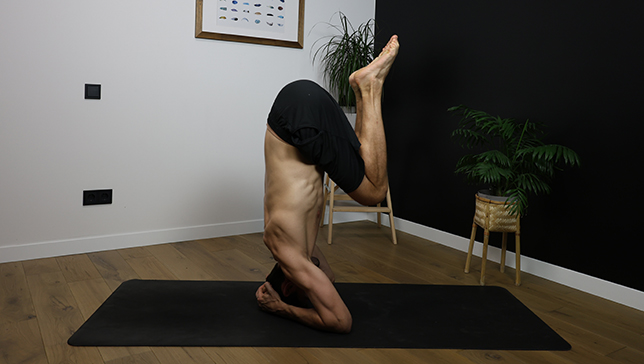Squeezing Pose - Akunchanasana

Contents
Squeezing Pose is also known as Supported Headstand Tuck or Akunchanasana is an advanced yoga pose that is also known as Salamba Sirsasana Tuck. It is a variation of the traditional Supported Headstand pose, which requires a strong core, upper body strength, and good balance.
Squeezing Pose can be a challenging pose that requires strength, balance, and concentration. It can help to strengthen the core muscles, improve balance and focus, and promote a sense of calm and relaxation. However, it is important to practice this pose safely and with caution, especially if you are a beginner or have any injuries or limitations. It is always a good idea to work with a qualified yoga teacher who can guide you through the pose and provide modifications or adjustments as needed.
Pose Detail
- Difficulty: Advanced, Intermediate
- By Type: Arm Balance Yoga Poses, Balancing Yoga Poses, Strengthening Yoga Poses
- Body Position: Inversion Yoga Poses
- By Benefit: Yoga Poses For Stress Relief
Step-by-Step Instructions
Benefits and Contraindications
Improves balance and focus
Help to calm the mind and relieve stress and anxiety
Strengthens core muscles
Increases circulation
High blood pressure
Neck injuries
Menstruation
Pregnancy especially during the second and third trimesters
Modifications and Props for Beginners
- Practicing Squeezing Pose at the wall nearby can provide extra support and help you feel more secure. Start with your head and forearms against the wall and slowly walk your feet up the wall until your hips are over your head.
- Placing a block between your hands can help to engage the muscles in your upper back and shoulders and provide extra support.
- Placing a folded blanket or cushion under your head can help to cushion your neck and make the pose more comfortable.
Useful Tips
- Engaging your core muscles throughout the pose can help to improve your balance and stability.
- Taking slow, deep breaths can help to calm the mind and relax the body, making the pose easier and more comfortable.
Frequently Asked Questions
It is not recommended to do Squeezing Pose or its variations if you have any neck problems or injuries. It is always best to consult with a qualified yoga teacher or healthcare professional before attempting any yoga pose.
Yes, Squeezing Pose can help to calm the mind and reduce stress and anxiety. It can also improve blood flow to the brain and help to increase focus and concentration.
Squeezing Pose primarily works the shoulder, arm, and core muscles. It also strengthens the neck and improves blood flow to the head.
It is best to hold the pose for 30 seconds to 1 minute, gradually increasing the time as you become more comfortable and confident in the pose.
Variations
- Supported Headstand Tuck
- Bound Squeezing Pose
- Half Lotus Headstand Tuck